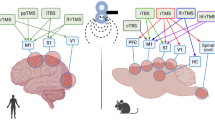Abstract.
In the central nervous system, astrocytes form an intimately connected network with neurons, and their processes closely enwrap synapses. The critical role of these cells in metabolic and trophic support to neurons, ion buffering and clearance of neurotransmitters is well established. However, recent accumulating evidence suggests that astrocytes are active partners of neurons in additional and more complex functions. In particular, astrocytes express a repertoire of neurotransmitter receptors mirroring that of neighbouring synapses. Such receptors are stimulated during synaptic activity and start calcium signalling into the astrocyte network. Intracellular oscillations and intercellular calcium waves represent the astrocyte’s own form of excitability, as they trigger release of transmitter (i.e. glutamate) via a novel process sensitive to blockers of exocytosis and involving cyclooxygenase eicosanoids. Astrocyte-released glutamate activates receptors on the surrounding neurons and modifies their electrical and intracellular calcium ([Ca2+]i) state. These exciting new findings reveal an active participation of astrocytes in synaptic transmission and the involvement of neuron-astrocyte circuits in the processing of information in the brain.
Similar content being viewed by others
Author information
Authors and Affiliations
Additional information
Received 15 July 1999, received after revision 9 September 1999
Rights and permissions
About this article
Cite this article
Vesce, S., Bezzi, P. & Volterra, A. The active role of astrocytes in synaptic transmission. CMLS, Cell. Mol. Life Sci. 56, 991–1000 (1999). https://doi.org/10.1007/s000180050488
Issue Date:
DOI: https://doi.org/10.1007/s000180050488




